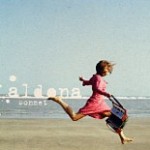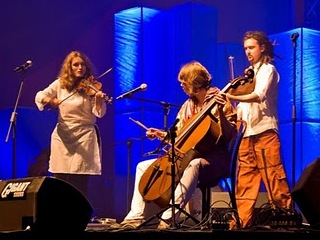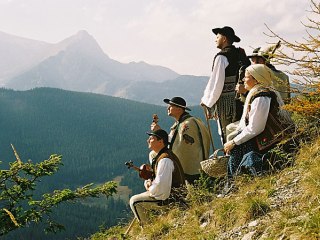FolkWorld #48 07/2012
© Wikipedia, the free encyclopedia
Music of Poland
Between 8 June and 1 July 2012, Poland alongside with the
Ukraine[48]
will host the
UEFA European Football Championship.
Plans to go over? Care to see some roots music?
 Republic of Poland (Rzeczpospolita Polska)
Capital:
Republic of Poland (Rzeczpospolita Polska)
Capital: Warsaw
Population: 38,2 mio.
Location:
Poland is a country in Central Europe, bordered by Germany to the west; the Czech Republic and Slovakia to the south; Ukraine, Belarus and Lithuania to the east; and the Baltic Sea and Kaliningrad Oblast, a Russian exclave, to the north.
Artists from Poland, including famous composers like Chopin or Lutosławski and traditional, regionalized folk musicians, create a lively and diverse music scene, which even recognizes its own music genres, such as poezja śpiewana.
Beginning
The origin of Polish music can be traced as far back as the 13th century, from which manuscripts have been found in Stary Sącz, containing polyphonic compositions related to the Parisian Notre Dame School. Other early compositions, such as the melody of Bogurodzica, may also date back to this period. The first known notable composer, however, Mikołaj z Radomia, lived in the 15th century. The melody of Bóg się rodzi by an unknown composer was a coronation polonaise for Polish kings.
During the 16th century, mostly two musical groups - both based in Kraków and belonging to the King and Archbishop of Wawel - led the rapid innovation of Polish music. Composers writing during this period include Wacław z Szamotuł, Mikołaj Zieleński, and Mikołaj Gomółka. Diomedes Cato, a native-born Italian who lived in Kraków from about the age of five, became one of the most famous lutenists at the court of Sigismund III, and not only imported some of the musical styles from southern Europe, but blended them with native folk music.
17th and 18th centuries
In the last years of the 16th century and the first part of the 17th century, a number of Italian musicians were guests at the royal courts of Sigismund III Vasa and Władysław IV. These included Luca Marenzio, Giovanni Francesco Anerio, and Marco Scacchi. Polish composers from this period focused on baroque religious music, concertos for voices, instruments, and basso continuo, a tradition that continued into the 18th century. The best-remembered composer of this period is Adam Jarzębski, known for his instrumental works such as Chromatica, Tamburetta, Sentinella, Bentrovata, and Nova Casa. Other composers include Grzegorz Gerwazy Gorczycki, Franciszek Lilius, Bartłomiej Pękiel, Stanisław Sylwester Szarzyński and Marcin Mielczewski.
In addition, a tradition of operatic production began in Warsaw in 1628, with a performance of Galatea (composer uncertain), the first Italian opera produced outside Italy. Shortly after this performance, the court produced Francesca Caccini's opera La liberazione di Ruggiero dall'isola d’Alcina, which she had written for Prince Władysław three years earlier when he was in Italy. Another first, this is the earliest surviving opera written by a woman. When Władysław was king (as Władysław IV) he oversaw the production of at least ten operas during the late 1630s and 1640s, making Warsaw a center of the art. The composers of these operas are not known: they may have been Poles working under Marco Scacchi in the royal chapel, or they may have been among the Italians imported by Władysław.
The late 17th and 18th century saw a decline of Poland, which also hindered the development of music. Some composers attempted to create a Polish opera (such as Jan Stefani and Maciej Kamieński), others imitated foreign composers such as Haydn and Mozart.
The most important development in this time, however, was the polonaise, perhaps the first distinctively Polish art music. Polonaises for piano were and remain popular, such as those by Michał Kleofas Ogiński, Karol Kurpiński, Juliusz Zarębski, Henryk Wieniawski, Mieczysław Karłowicz, Józef Elsner, and, most famously, Fryderyk Chopin. Chopin remains very well known, and is regarded for composing a wide variety of works, including mazurkas, nocturnes, waltzes and concertos, and using traditional Polish elements in his pieces. The same period saw Stanisław Moniuszko, the leading individual in the successful development of Polish opera, still renowned for operas like Halka and The Haunted Manor.
Traditional music
Polish folk music was collected in the 19th century by Oskar Kolberg, as part of a wave of Polish national revival. With the coming of the world wars and then the Communist state, folk traditions were oppressed or subsumed into state-approved folk ensembles. The most famous of the state ensembles are Mazowsze and Śląsk, both of which still perform. Though these bands had a regional touch to their output, the overall sound was a homogenized mixture of Polish styles. There were more authentic state-supported groups, such as Słowianki, but the Communist sanitized image of folk music made the whole field seem unhip to young audiences, and many traditions dwindled rapidly.
Polish dance music, especially the mazurka and polonaise, were popularized by Frederick Chopin, and they soon spread across Europe and elsewhere. These are triple time dances, while five-beat forms are more common in the northeast and duple-time dances like the krakowiak come from the south. The polonaise comes from the French word for Polish to identify its origin among the Polish aristocracy, who had adapted the dance from a slower walking dance called chodzony. The polonaise then re-entered the lower-class musical life, and became an integral part of Polish music.
Podhale
While folk music has largely died out in Poland, especially in urban areas, the tourist destination of Podhale has retained its traditions. The regional capital, Zakopane, has been a center for art since the late 19th century, when people like composer Karol Szymanowski, who discovered Goral folk music there, made the area chic among Europe's intellectuals. Though a part of Poland, Podhale's musical life is more closely related to that found in the Carpathian mountains of Ukraine, Slovakia, Moravia in Czech Republic and Transsylvania. The people in the Tatra mountains of Poland and Slovakia are descendants of Vlach shepherds who settled there from 14th to 17th century.
Local ensembles use string instruments like violins and a cello to play a distinctive scale called the Lydian mode. The distinctive singing style used in this scale is called lidyzowanie. The lead violin (prym) are accompanied by several second violins (sekund) and a three-stringed cello (bazy). Duple-time dances like the krzesany, zbójnicki (Brigand's Dances) and ozwodna are popular. The ozwodna has a five bar melodic structure which is quite unusual. The krzesany is an extremely swift dance, while the zbójnicki is well-known and is perceived as being most "typical" of Podhale and Northern Slovakia. Folk songs typically focus on heroes like Janosik.
Other regions
Outside of Podhale, few regions have active folk scenes, though there are music festivals, such as the Kazimierz Festival, which are well-known and popular. Regional folk bands include Gienek Wilczek Band (Bukowina), Tadeusz Jedynak Band (Przystalowice Male), Stachy Band (Hazców nad Wislokiem), Franciszek Gola Band (Kadzidło), Edward Markocki Band (Zmyslówka-Podlesie), Kazimierz Kantor Band (Głowaczowa), Swarni Band (Nowy Targ), Kazimierz Meto Band (Glina), Ludwik Młynarczyk Band (Lipnica) and Trebunie-Tutki.
From Wikipedia, the free encyclopedia
[en.wikipedia.org/wiki/Music_of_Poland].
Wikipedia® is a registered trademark of the Wikimedia Foundation, Inc., a non-profit organization.
Text is available under the Creative Commons Attribution-ShareAlike License.
Date: April 2012.
Photo Credits:
(1) Europe (by FolkWorld);
(2) Polish Colours, (3) Warsaw Village Band,
(4) Jarek Adamów,
(5) Trebunie Tutki (unknown).
FolkWorld - Home of European Music
 Layout & Idea of FolkWorld © The Mollis - Editors of FolkWorld
Layout & Idea of FolkWorld © The Mollis - Editors of FolkWorld





